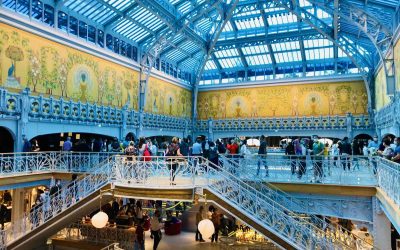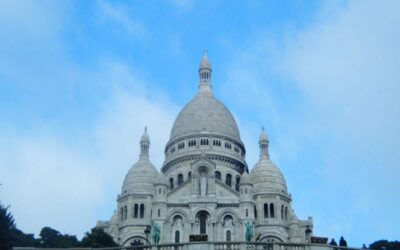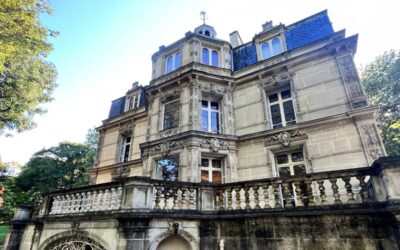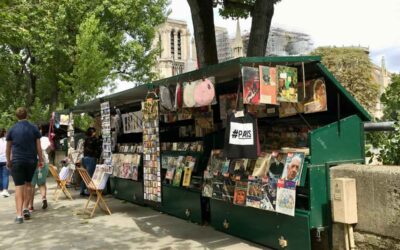The Marais district of Paris has a long and rich history. From being the epicenter of medieval Paris, to the forefront of the French revolution during the storming to the Bastille, the Marais is a fascinating area to visit if you are visiting Paris.
These days however, the Marais is better known for its art galleries, vintage stores, and endless number of bars, restaurants, and cafés.
As one of the most charming neighborhoods in Paris, the Marais is famous for its buzzing streets many of which are pedestrianized, its small shops, and historical architecture that are much livelier than some other parts of the city.

This is a district is famous for its brasseries, bars, and nightlife that attract people from all over the world. And the best part is that the Marais is in the central part of Paris, meaning that it is easily accessible by metro or bus.
You can easily find a good selection of hotels in the area (more on this later) and things to do in the neighborhood. All in all, the Marais is a great place hang out in while visiting Paris, so let’s see all there is to do there, shall we? Allons-y!
What does the Marais mean?
The “Marais” actually means swamp or wetlands, as this area used to be subject to frequent flooding.
While much of the city of Paris developed on the Ile de la Cité and in the Latin quarter dating back to Roman times, it was not until the 9th century that drainage channels were built in the area, allowing farmland to develop here.
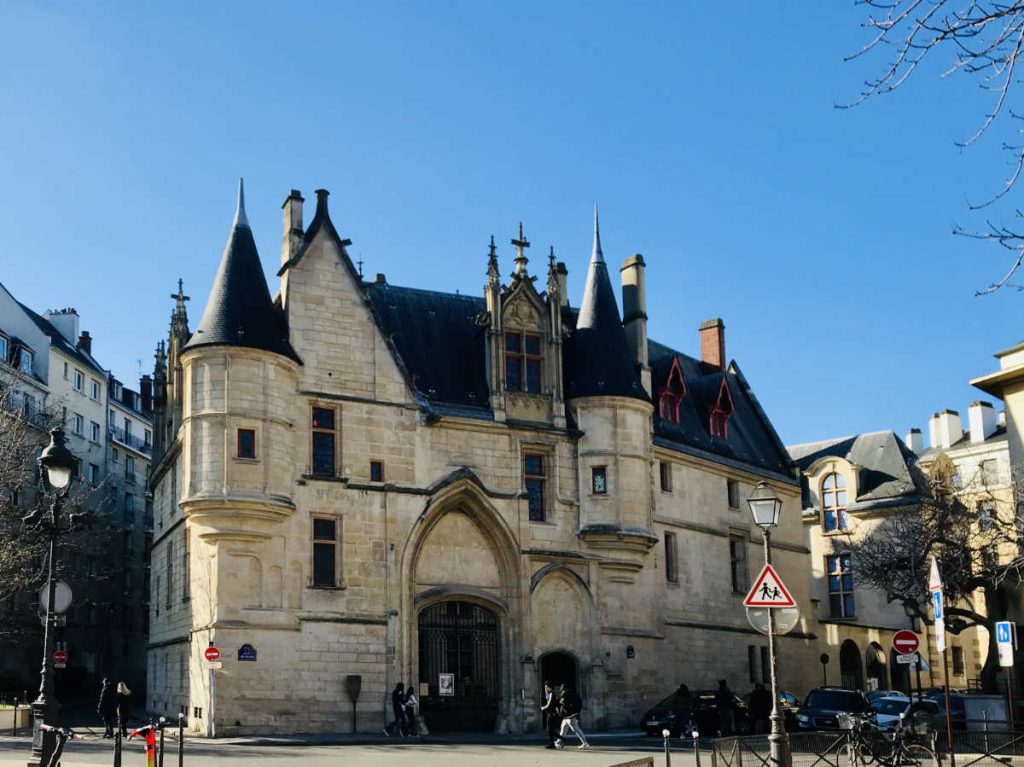
The farmland eventually gave way to larger settlements to become a “beau borg“, meaning “beautiful city” and became known as the Marais district. Today it is a bustling neighborhood that is much sought after as a place to live and play, with plenty of bars and restaurants around.
Places to visit
1. Place des Vosges
Originally known as Place Royale, Place des Vosges is one of the most beautiful spots in the Marais, and indeed, in all of Paris.
It is located off of Rue Saint Antoine in the 3rd–4th arrondissement and it is where the rich and famous used to live. And in fact still do, as house prices around here are more than double what it is in the surrounding buildings.
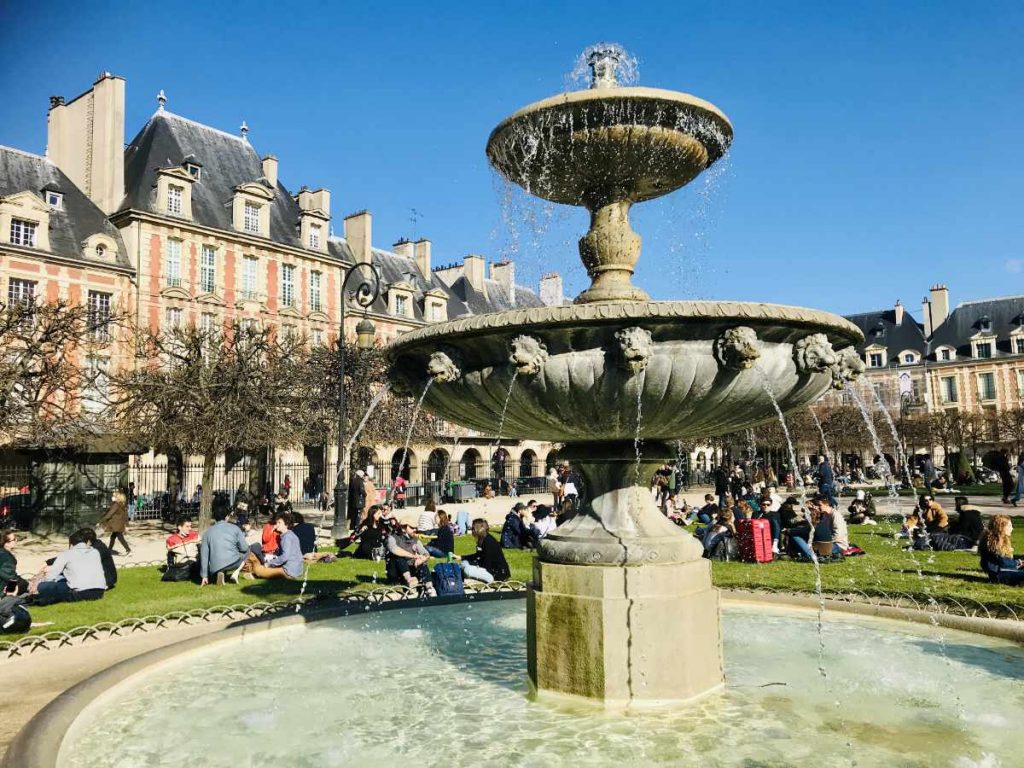
The last French queen to live was Anne of Austria in the 1600s. However, this sumptuous building in the heart of Paris has remained emblematic of the divide between the rich and the poor.
At the time of the French Revolution in 1789, this area was surrounded by a medieval city, with buildings very close together and poor sanitation. At the time, there were no wide boulevards and Hausmannian architecture. Place des Vosges was a luxurious building where the nobility lived; the nobles who didn’t pay taxes like the commoners did.
Before the Revolution, even access to the gardens was forbidden, except on one day of the year, August 25, the feast of Saint Louis.
You can imagine that this was one of the first places taken over by “the people” and it was successively renamed several times:
- place des Fédérés – Federate square
- place du Parc-d’Artillerie – Artillery park square
- place de la Fabrication-des-Armes – Maker of weapons squre
- place de l’Indivisibilité – Indivisible square
In 1800, it was renamed “Place des Vosges” in honor of the Vosges regional department, which was the first to have paid tax under the French Revolution and, send volunteers to defend the “patrie” (country) in danger.
These days it is filled with picnickers ready to enjoy a bit of fresh air and sunshine. There are several art galleries and cafés in the buildings that surround the Place des Vosges, and it is wonderful place to have a coffee (or a beer).
You can read more about the Place des Vosges here. You can also take a guided walking tour through the area to hear about the Marais’s famous residents and how this area has changed over time.
2. Centre Pompidou
Centre Pompidou in the heart of the Marais is a modern art gallery built by the ex-President of France, George Pompidou. (You can read more about Pompidou’s questionable decor choices here.)

The building itself is a piece of art as an ‘inside-out’ building in with its structural system, mechanical systems, and circulation exposed on the exterior of the building.
All of the functional structural elements of the building are color-coded: green pipes are plumbing, blue ducts are for climate control, electrical wires are encased in yellow, and circulation elements and fire safety devices are red.
It holds hundreds of famous artworks from the 1970s onwards, from Andy Warhol to Lucien Freud. You can read more about the Centre Pompidou and book your tickets in advance here.
3. Hotel de Ville de Paris
One of the most impressive looking buildings in the Marais has to be the Hotel de Ville of Paris.

This is the city of Paris‘s main mayoral office, although each arrondissement has its own mayoral office as well. (When Parisians give birth or want to get married, they go to their own arrondissement mayoral office, but for larger works like city maintenance and organization, it is this Hotel de ville in the Marais.)
While you cannot visit inside the Hotel de Ville, the neo-renaissance building is spectacular and often has events in front of it (concerts in the summer and an ice-skating rink in winter).
4. Musée Nationale Picasso
Pablo Picasso was not born in France, but he was so emblematic of the art scene in Paris, that he has to be on the list of the greatest artists in France. He first visited Paris at the age of 19 and would eventually move to France, dying at the age of 91 in Mougins, France.
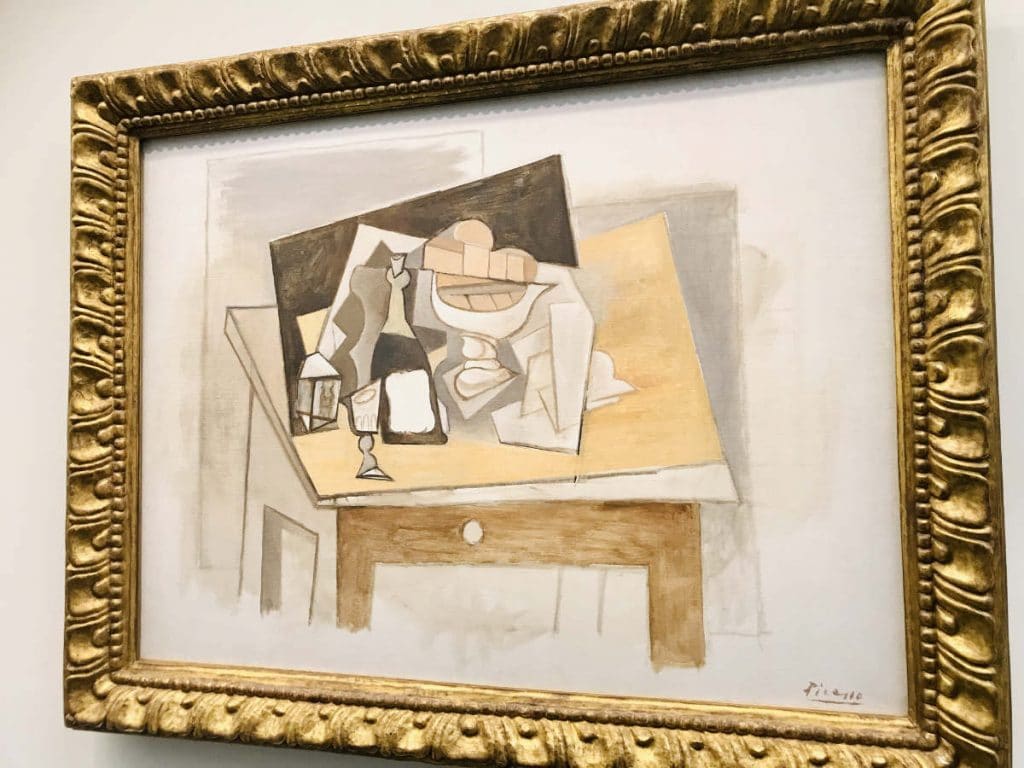
With a varied neo-classical style, he became one of the best-known figures in the 20th-century art world and beyond.
Because Picasso was a long-time resident and died in France, his estate was subject to French succession laws. France permits heirs to pay inheritance taxes with works of art instead of money, as long as the art is considered an important contribution to the French cultural heritage.
As such, his family donated thousands of works of art (paintings, sculptures, drawings, prints, and notebooks), along with personal papers, correspondence, and more. They also donated works that he had collected from his fellow artists including Renoir, Cézanne, Degas, Rousseau, Seurat, and Matisse.
While some of these works are now at Musée d’Orsay and the Orangerie, the largest collection of Picassos are at the Musée Nationale Picasso in the Hôtel Salé on rue de Thorigny, in the Marais district. You can get your skip-the-line tickets for the Picasso museum here.
5. Maison de Victor Hugo
One of France’s most famous writers and poets has to be Victor Hugo. With a career spanning over 60 years, he wrote everything from poetry to satire, critical essays and historical odysseys.
His most popular works that have been translated into over 60 languages have to be Les Miserables and Hunchback of Notre Dame (which was not intended to be a children’s tale). He was also renowned for his poetry collections, such as Les Contemplations (The Contemplations) and La Légende des siècles (The Legend of the Ages).
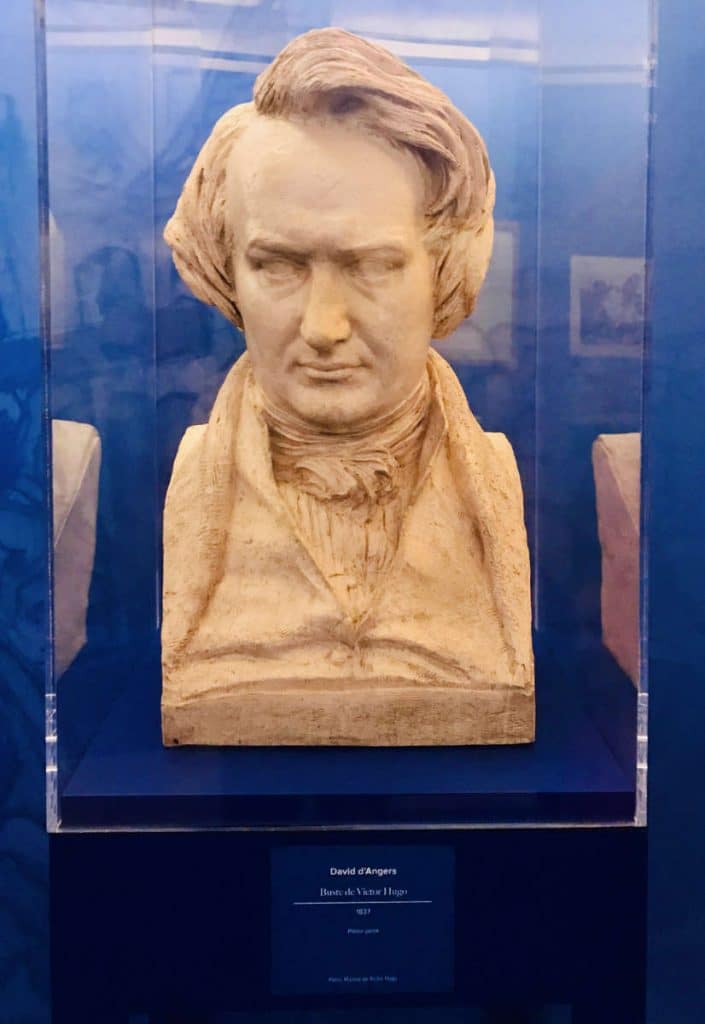
But Victor Hugo did more than just write fictional novels. He was also a passionate supporter of republicanism after the Revolution, and served in politics as a deputy in the Assemblée Nationale, as well as a senator.
He gave several speeches to end poverty, as well as to establish universal suffrage (for women) and free education for all children. His advocacy in the 19th century to abolish the death penalty became renowned internationally.
His advocacy even had him briefly expelled from France (he went to Belgium) before being allowed back. For his works and service to the French nation, he is buried in the Panthéon in Paris.
His home in the Marais, a 280 sqm apartment in the Place des Vosges has been converted into a museum called the Maison de Victor Hugo. He lived in this rented apartment with his wife for 16 years between 1832–1848. The museum covers the various periods of his life, including various drawings he did over the course of his life.
6. Marché des Enfants Rouges
The oldest food market remaining in Paris today, the Marché des Enfants Rouges is a covered market dating to 1615 and is an official historic monument.
The name “market of the red children” and is due a nearby orphanage called Hospice des Enfants-Rouges, that would take in stray children found on the streets of Paris.
Inside the market you will find a variety of farmers’ stalls with fruits and vegetables, as well as other producers of cheese, wine, flower stalls, as well as a selection of eclectic street food to takeaway. You can read more about outdoor markets in Paris here.
7. Carnavalet Museum
If you are interested in the history of Paris, you may want to make a stop at the Carnavalet Museum in the Marais.
Inside the museum, the exhibits show the transformation of the Roman village of Lutèce, which was inhabited by the Parisii tribes to the grand City of Lights that we see today.
The Carnavalet museum houses over 2,600 paintings, 20,000 drawings, 300,000 engravings and 150,000 photographs, along with 2,000 modern sculptures and 800 pieces of furniture.
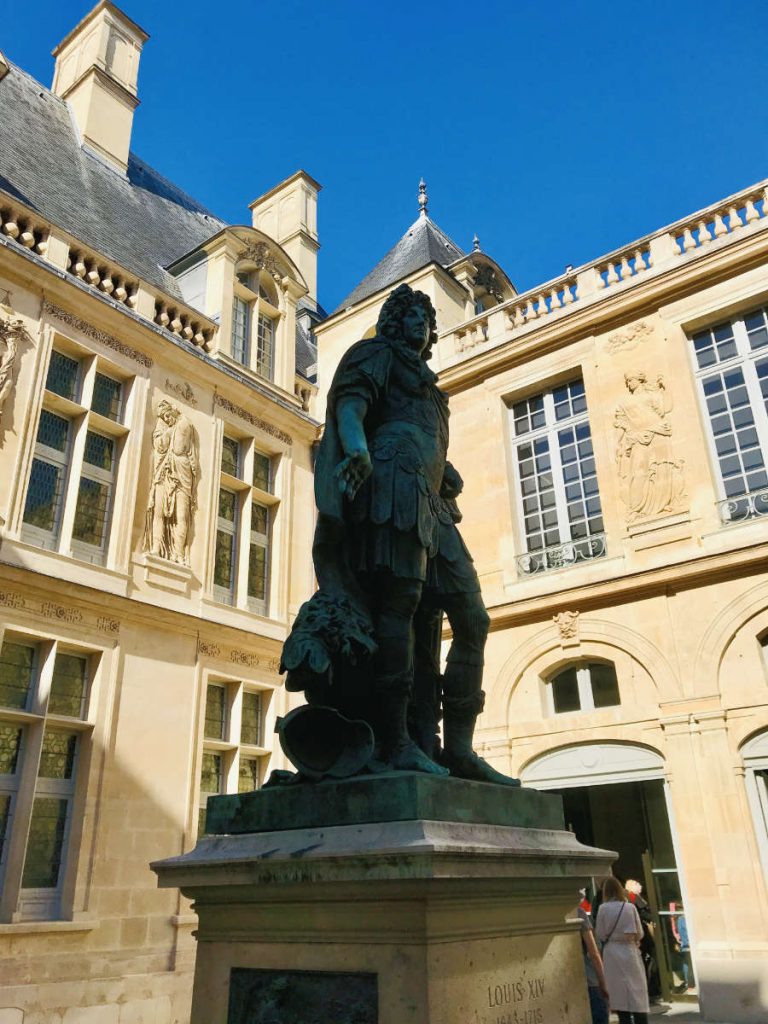
In the courtyard, there is a sculpture of the Sun King Louis XIV, who built the Palace of Versailles and had such a profound effect on Paris during his long reign.
Entry to the permanent exhibition halls is free, although you may need to reserve a timeslot. You can find more free museums in Paris here.
8. Musée de la Chasse et de la Nature
If you are travelling with young children, you may want to make an side stop at the Musée de la Chasse et de la Nature (Museum of Hunting and Nature).
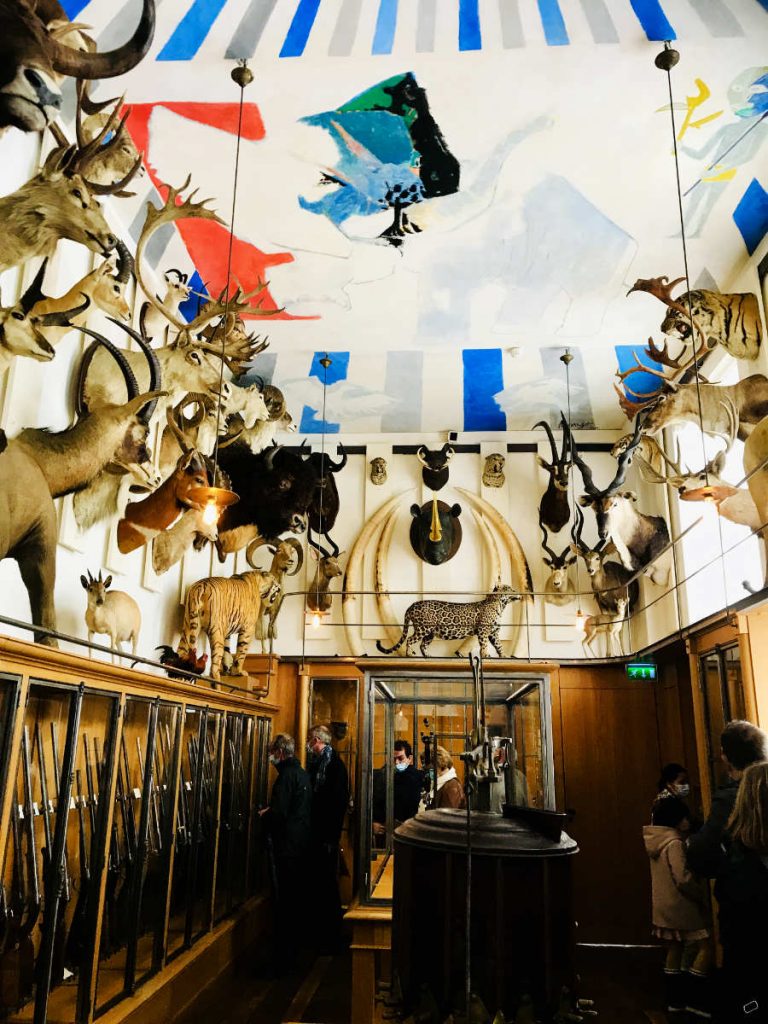
With a variety of paintings dedicated to animals and the hunt, there are also stuffed animal collections and hunting weaponry.
The building itself is also quite impressive, having previously been two private mansions dating back to the 17th century, that were connected together. You can read more about the Museum of Hunting and Nature here.
Where to stay: Best hotels in the Marais
The Marais is one of the most sought after places to stay in Paris, and it is not hard to see why. It is quite central, with most of the main sights in Paris within walking distance and with good metro connections to the rest of the city.
I have selected hotels that have a bit of that oh-so-chic Parisian charm to them, with classical French furnishings and design. Along with being beautifully decorated, the most highly recommended hotels in the area include:
- €€€ – Hôtel Le Relais des Halles – on a quiet pedestrian street in the heart of the Marais
- €€€€ – Cours des Vosges – in Place des Vosges
- €€€€ – Roi de Sicile – luxury apartment hotel on Rue de Rivoli
- €€€€€ – Le Pavillon de la Reine & Spa – in Place des Vosges
You can see more accommodation in the 4th arrondissement here.
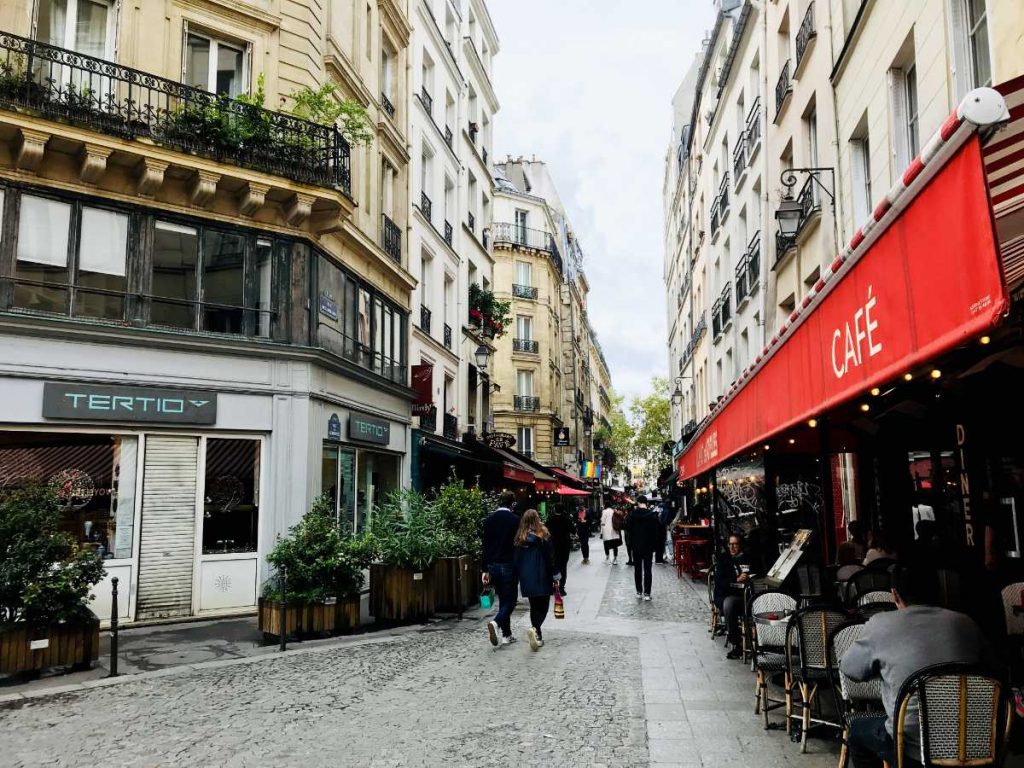
Where to eat
1. Michelin-starred restaurants
You are only in Paris once (or once this week), so why not dine in style? The top Michelin-starred restaurants in the Marais are:
- Restaurant H by Chef Hubert Duchenne – 13 Rue Jean Beausire, 75004 – 1 Michelin star restaurant with tasting menus serving 5 to 7 dishes, Chef Duchenne was elected best young talent in French gastronomy in 2015.
- L’Ambroisie by Chef Bernard Pacaud – 9 Place des Vosges, 75004 – 3 Michelin starred restaurant in the Place des Vosges, luxury and refinement at its finest.
- Restaurant Benoit Paris by Chef Alain Ducasse – 20 rue Saint Martin 75004 – Opened in 1912, this is one of the few Parisian bistros to have a Michelin star in its pocket.
2. Haute Marais
There are plenty of restaurants in the Haute Marais, which is the northern part, the furtherest away from the Seine river. Our favorites are:
- Des Gars dans la Cuisine – 72 Rue Vieille du Temple, 75003 – a chic French bistro with a bit of a global twist. Noted in the Michelin guide.
- Café Charlot – 38 Rue de Bretagne, 75003 – Excellent cocktails on a great terrasse to watch the passerbys go about their day. International menu with French classics along with the occasional burger.
- Breizh Café – 109 Rue Vieille du Temple, 75003 – a lovely crêperie that always has a lot of different varieties to try.
3. Rue des Rosiers
The Marais’s bustling Jewish district is well known for one particular restaurant, the L’As du Falafel at 34 Rue des Rosiers. It isn’t the fanciest of places, but if you are looking for good middle-eastern cuisine, this is it.
With long queues stretching out the street, it is no wonder that several similar restaurants have popped up alongside it, trying to coax visitors to their doors instead.
The area is fully pedestrianized so take your time to walk around, look at the lines, and pick your favorite.
4. Around Metro Saint Paul and Rue de Rivoli
There are a lot of bobo chic restaurants in this area, along with the odd English pub and sushi restaurant. Our favorites include:
- Les Philosophes – 28 Rue Vieille du Temple, 75004 – All the classic French recipes, with great service and copious portions.
- Chez Mademoiselle – 16 Rue Charlemagne, 75004 – A mix of seafood and meat dishes in a friendly setting with a nice terrasse to enjoy in good weather.
- Pamela Popo – 15 Rue François Miron, 75004 – Romantic decor and excellent food, what could be better? A refined French menu that is sure to please.
You can read more about foods and drinks to try in Paris here.

Bars and Nightclubs
Le Marais has come a long way since its days as a swamp. Today it is filled with wine bars, pubs, and restaurants that it is quite hard to narrow it down. One of the top areas for nightlife in Paris, it also has a vibrant gay community in the area, so there are also plenty of gay bars nightclubs in the area.
Most of these places are quite small and don’t take reservations, so I would recommend walking around Rue Quincampoix and its surrounding streets to see where you can find a table.
1. Rooftop Bar in the Marais
- Le Pechoir Marais (from top of the BHV building, beautiful views of Hotel de Ville and the rest of Paris).
2. Wine Bars and Cocktails Lounges
- Le Komptoir – 27 Rue Quincampoix, 75004 Paris
- Le Piment Café (small traditional French bar) – 15 Rue de Sévigné, 75004 Paris
- The Brklyn (good for cocktails) – 58 rue Quincampoix, 75004, Paris
- Candelaria (Mexican taqueria and cocktail bar specializing in agave spirits) – 52 Rue de Saintonge, 75003 Paris
- Lizard Lounge (American vibe. With DJ and dancing in the basement after 9 on weekends.) – 18 Rue du Bourg Tibourg, 75004 Paris
- Sherry Butt (whiskey and artisanal cocktails) – 20 Rue Beautreillis,75004 Paris
3. LGBT and Gay bars
- Freedj (club on 2 levels) – 35 Rue Sainte-Croix de la Bretonnerie, 75004 Paris
- Le Tango (a bal musette playing greatest hits) – 13 Rue au Maire, 75003 Paris
- L’Enchanteur (on 2 levels, with karaoke, bills itself as the friendliest place in the Marais) – 15 Rue Michel-le-Comte, 75003 Paris
You can find more nightlife options in Paris here.
Shopping
1. BHV – Bazar de l’Hôtel de Ville
Just across from the Hotel de Ville is the grand magasin (large shop) called the BHV. It is part of the same group that owns the famed Galerie Lafayette shops.
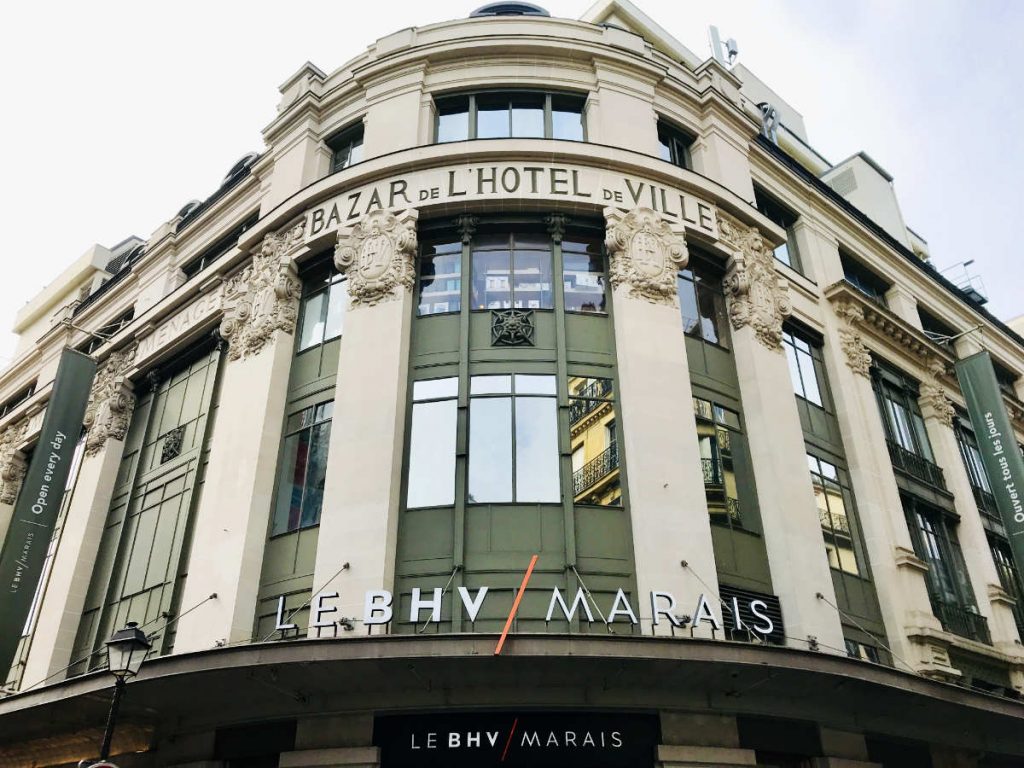
The large building is fully occupied by BHV with 6 floors and an underground, selling everything from clothing and shoes, to kitchen items and DIY tools. Prices vary from luxury to more modest items.
There is also a superb rooftop bar and restaurant on the top floor with excellent views all across the city.
2. Vintage shops
There are several vintage shops in the Marais with some of the most notable being:
- Come on Eileen – 40 Rue de Rivoli, 75004 – Vintage designer pieces from the 1960s to most recent times. If you are looking for that lightly-used Chanel or Hermes jacket, this might be your best bet.
- Tilt Vintage Paris – 8 Rue de Rivoli, 75004 – Second hand finds from the 1960s onwards, that are reasonably priced in near mint condition. They also have an online store.
- Free’P’Star – 61 Rue de la Verrerie, 75004 – clothing for women and men, including 1-euro bins. Stock changes often, so go with an open mind.
3. Forum des Halles
Just steps away from the Marais is the Halles shopping center. If you are looking for a mall, Les Halles in the heart of Paris is it.
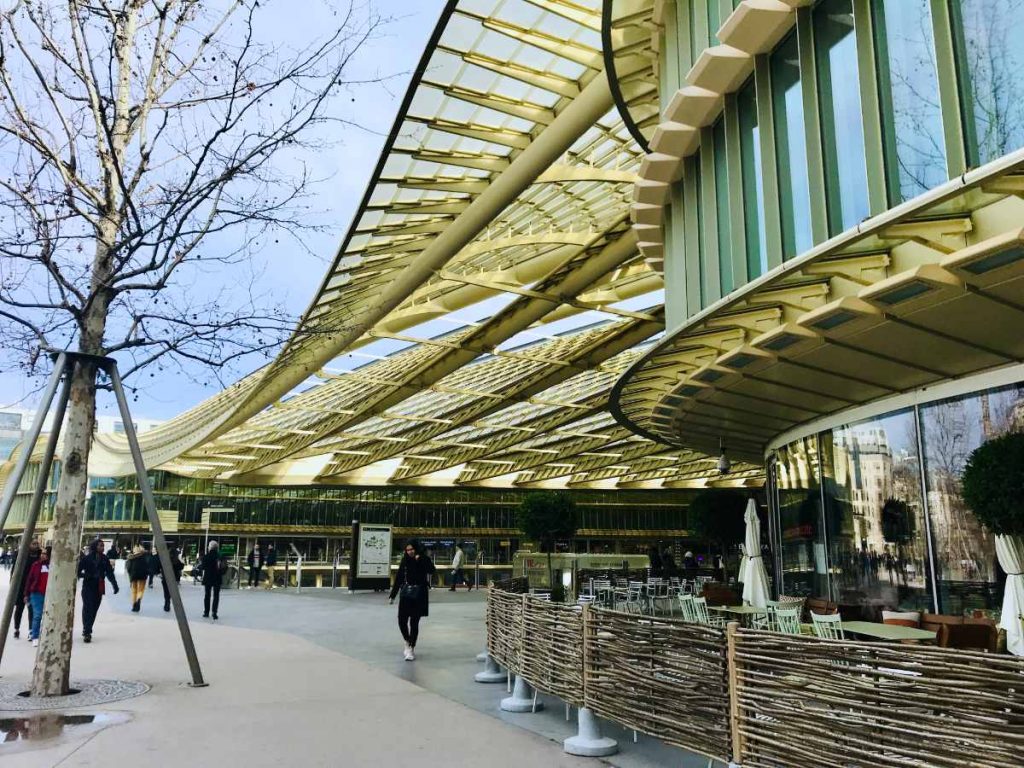
Including everything from Zara to Mango and more, there are plenty of shops for all your shopping needs, protected from the vagaries of Parisian weather.
Much of the Forum des Halles is underground, including the movie theatre, and connects directly to the metro. It was newly renovated in 2019 and is one of the most visited malls in France. You can read more about shopping in Paris here.
How to get around
There are several metro stations in the area, but the easiest to find yourself on is Metro Line 1 at Saint Paul and Bastille. Place de la République is also a good metro station to head to.
It is also very close to Chatelet-Les Halles RER and train station, which has direct connections to Charles de Gaulle airport, La Défense area and just about every other point across Paris.
The area is quite small and very walkable, so once you do get to the Marais, don’t hesitate to explore on foot.
Is the Marais district in Paris safe?
Paris in general has a lot of pickpockets and petty crime, and the Marais is no different. Remain alert and leave your valuables at home. You can read more about what not to do in Paris here.
How do you pronounce Marais in French?
If you want to sound like a local Parisian, the Marais is pronounced “ma-ray” in French. The original meaning of Marais in French is “swamp”.
What arrondissement is the Marais district?
The Marais covers much of the 3rd and 4th arrondissements of Paris. The historic Marais neighborhood does not have any administrative status, so it does not have a defined border.
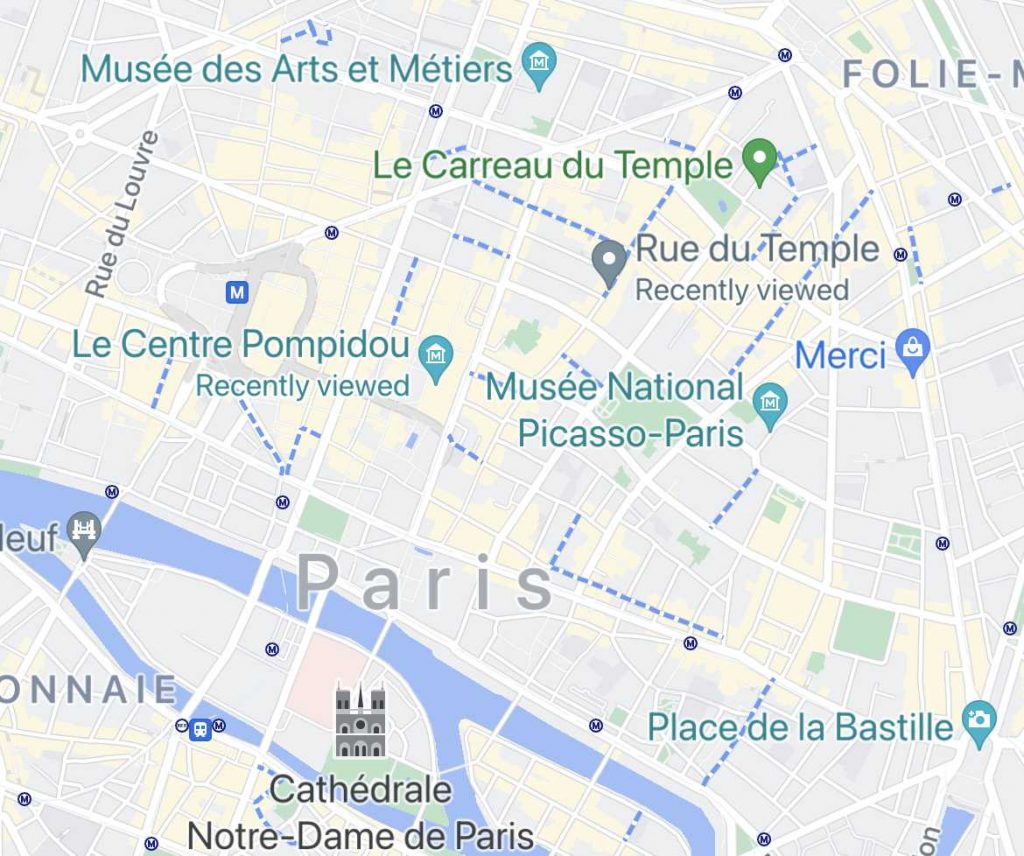
Roughly, it starts at Carreau du Temple in the north to Place de la Bastille on the east, the quay of the Seine in the south, and Centre Pompidou on the west.
Is the Marais expensive?
It is a highly sought after area for accommodation, but in terms of shops, bars, and restaurants, there are plenty of options for a wide variety of budgets. It isn’t the most expensive area in Paris, that honor belongs to the 5th, 6th, 7th and 8th arrondissement around the Champs Elysées.

If you enjoyed that article, you may enjoy reading more about top things to do in Paris. A bientôt!

